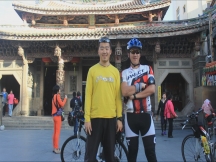












2009
垃圾堆與天人合一 (張曉風)
一
他不會說華語——雖然他會廣東話。
他當然更不會寫漢字,屬於他的語文其實是英文。
他是生活在加拿大的華裔移民,從母親那邊來說,他是第四代移民,從父親那邊來說,是第二代。小鎮上沒有其他華人,他們看來顯然是徹頭徹尾的加拿大人了,他並且有一個好玩的英文名字,叫「自由人」(Freeman),看來會一路踔厲風發昂揚走天下的樣子。
然而他學了建築,建築是一項「駐足」的藝術,他必須「座落」。
而且,他戀愛了,愛上一位從香港來的華人女子,然後,他和那女子一起回到香港。
他的名銜是建築師,也在中文大學教書,他妻子是個「公益活動人」。歲月悠悠,二十多年就這樣過去了。在香港,他的名字是陳惠基,他的妻子叫李淑潔,像迴流的鮭魚,他們又找到遙遠的故川故源。
二
去年,中華民國筆會赴港開會,有一天晚上,大會安排了一個公開的朗誦會,朗誦的地點是新亞書院的一個小禮堂。因為算是盛事,我們便早早由開會的西貢島前往中文大學,召了輛計程車,懷覑十分慎重的「準備心情」。
余光中先生因為有事,要另外一車去,臨行,他十分認真地叮嚀:「你們去,時間還早,你們一定要上到山頂位置,有一個景非常值得一看,叫『天人合一』,是紀念錢穆先生的。」
香港遊,余先生可算半個「地頭龍」,我們把他的話奉為圭臬。
我們原以為那一定是一處人人皆知的景點,不料計程車司機卻木然不曉,於是在校園的山徑上彎來繞去,四處打聽,偏偏如今校園中每每見到的都是些十分「國際化人士」,都是些對校園知之不甚詳的外地學生。不過,在暮色來襲之前,我們總算找到了這個玄秘的幽境。
我要怎樣形容這片幽境呢?我的第一個感覺是:「啊!原來它是一池水,藏在一個深邃的洞穴裏。」
其實不對,它雖是一池水,卻不在洞穴裏,它的確有所覆,但覆蓋它的是一株老樹,樹不高,但枝繁葉茂,姿態如蟠螭交鶴偃蹇纏綿,顏色如翡翠巖壑,鋪天而來。但那大樹又宛似一個謙抑安全的戀慕者,雖站在近處,卻不企圖干擾什麼——除了影子,它只求池水容納它的影子。
聽說整個工程花的錢很少,當然,學院本來就不是富裕的單位,人文方面的學院一 向是大學裏的低收入戶,但這個景卻造得容天納地,氣象萬千。可是無論如何,香港和台灣一樣,是個「彈丸之地」,哪有什麼氣象萬千的本錢?可是,有的,那全 看建築師了。建築師是誰?就是剛才說的陳惠基。
陳惠基既不懂中文,要閱讀錢賓四先生是絕對不可能的,這一點,就全靠妻子李淑潔了。經過反覆的詮釋辯析,從年輕時即信仰基督教的陳惠基和賓四先生的儒境終於有了交集,他隱約知道該怎麼做了。
這塊山頭之地,原來的功能只是堆雜物,形同垃圾場,經過整理,成了「天人合一」造境的預定地。決定從步道開始,到大樹保留,到造一座池水,水池在我目測 看來,也不過二十幾坪(每坪約四平方公尺),但已足夠迴天光以入鏡,攬無窮於方寸。原來,他造了一片「浮沿水池」,(這不是工程用語,是我杜撰的,我老家 徐州稱斟酒至杯沿為「浮沿」。)水面一平如鑑,並不斷稍稍溢出,這種水池原不稀罕,台北縣政府辦公室即有一座。但「天人合一」勝境中,此池因設計精巧,剛 剛好和海平面在視覺上黏合起來,於是八仙嶺、吐露港全像由這一方池水延伸出去的校區分部。
這設計,讓我想起蘇州庭園,但借山借水的老師傅怎比得上陳惠基幸運,他借的竟是大海!浩浩淼淼出入有無的大海,清風徐來,興或不興的池面都令人恍神。
天人合一可以是倫理上的宇宙親情,可以是哲學方面的細密思維,也可以是眼前滌目浣心的深層美學。
也許是廿幾年了。這哲學之道上熙來攘往的訪客的清靜,沒入夢來。原來,它是給世世代代的人的,給那些新生們。他們的系譜之一,寫在梅棹忠夫和山本紀夫合編的《山的世界》(賴惠鈴譯 台北:臺灣商務,2007) 。平地之夢,山岳之夢。在台中公園旁的書店的羅素《哲學問題》中的室內桌椅之真象的立讀上。在羅素在哈佛大學Santayana 的房內,為主人朗讀某段英詩,讓Santayana 震憾,寫入《人與地》中。又或許在80年代初的竹東電子所的圖書館,在台北經建會宿舍的音樂中….. (京都一周トレイル(Trail))
![[image]](http://si.wsj.net/public/resources/images/RV-AJ650_ARCHIT_DV_20130208163803.jpg) Robert Harding World Imagery/Corbis
Robert Harding World Imagery/Corbis
 |
| 台大公務宿舍昨日凌晨傳出火警,木造平房陷入火海,險危及殷海光故居;警消緊急趕往撲滅火勢,未傳人員傷亡。 (記者廖振輝攝) |
 |
| 台大公務宿舍昨日凌晨傳出火警,木造平房陷入火海,險危及殷海光故。 (記者廖振輝攝) |
院子裡的苦澀身影:殷海光故居
| ||||||||||||
| ‧臺北畫刊 2011/03/23 | ||||||||||||
 「歷史的轉折」常常不是人智所能預料的。往往在一個時代,聲光畢露的運動,不一會就煙消雲散;又往往在一個時代,寂然無聞的大思想大觀念忽然像火山似的爆發出來,震撼著一個時代。 「歷史的轉折」常常不是人智所能預料的。往往在一個時代,聲光畢露的運動,不一會就煙消雲散;又往往在一個時代,寂然無聞的大思想大觀念忽然像火山似的爆發出來,震撼著一個時代。 | ||||||||||||
【文/宋祖慈 ;攝影/王能佑】
這是殷海光先生於民國58年所寫的自敘(節錄自《殷海光選集》),他當時胃癌復發,不久後便病逝。被譽為「臺灣大學最賣座教授」的他,自許為五四後 期人物,至於後人對他的論定,則是臺灣自由主義開山始祖與啟蒙大師。不過,他晚年被奪走發言舞台,位在溫州街18巷16弄底的宿舍,就曾因特務於巷口監 視,而在大門貼上不見學生的條子。這處住了13年的家,可是殷海光安身立命的所在? 一把鏟子 造一座院子 殷海光生於民國8年,也就是五四運動開始的那年。他前半生的30年歲月,都在中國大陸度過──到西南聯合大學求學,畢業後被延攬進《中央日報》擔任 主筆,並在金陵大學任教;直到民國38年來臺,才於臺大謀得教職,教授邏輯學。民國45年女兒出生後,殷海光向臺大申請宿舍,住進溫州街這棟房子。他人生 最輝煌的階段和最黯然的幾年,都在這裡度過。
在殷家搬進來時,故居的院子還是一片荒地,殷海光任教與寫作之餘,最大的興趣就是在這裡整地種樹。特別的是,他沿著圍牆挖了一條30公尺長的小河, 再把土方堆成一座小山;因為如同愚公移山,一點一滴自力改造地貌,所以他將小河取名為「愚公河」,小山則叫作「孤鳳山」,山上還種了兩棵松樹,現在都已長 得高大挺拔。 此幅山林小河之景,完全是殷海光的傑作,就連樹下的石桌石椅和水泥爐台,都是他自己砌成的!因為殷海光喜歡喝咖啡,戶外的石頭桌椅便是他與學生、朋友談心論學,並且享受一杯好咖啡的位子,夏君璐還特別學做點心,讓大家配著咖啡吃。 院子裡有一座水泥砌的小水池,是殷海光特別為女兒文麗造的戲水池,前後修改了5次,也可見這一家人的生活樂趣。 一枝健筆 寫自由民主 殷海光從《自由中國》雜誌創刊時就是撰稿者之一,多半書寫政論。民國40年代,《自由中國》在臺灣舉足輕重,幾乎是威權統治下唯一公開的異議之聲。除了影響臺大哲學系學風,殷海光的一枝健筆批判時政,呼籲實現自由、民主、科學,更啟迪了學術與社會良知。 例如李敖說殷海光是「蛟龍人物」,並在〈我的殷海光〉一文中寫道:「殷海光在《自由中國》這11年的表現裡,在使人頭腦清楚方面,做了中國有史以來沒人做得到的大成績。他以簡明的分析、高明的遠見、清明的文筆,為歷來糊塗的中國人指點了迷津。」
一棟房子 看苦澀歲月 雷震案發生後,打擊接踵而來,這棟故居讓人看見殷海光以一介知識分子,義無反顧地扮演反對黨,卻黯然失色的暮年生活......。 從故居入口走進室內,第一個房間是客廳兼餐廳,一牆之隔則是小廚房兼淋浴處。面對庭院的房間是殷海光的書房,但他伏案寫出一系列〈今日的問題〉社論 的書桌已經不在了,藏書也捐贈給臺大圖書館,只剩他講學與家居的黑白照,以及部分手稿副本。這些詩稿、座右銘、寫給當時臺大校長錢思亮的信件草稿、〈我被 迫離開臺灣大學的經過〉一文,以及警備總司令部的查禁書公文等,在在描繪他艱困的生活景況。 雜誌停刊,沒了批評時政的管道,殷海光本可繼續在學術上努力,但他在戒嚴時期鼓吹自由思想的舉動卻被政府盯上,最終被迫離開臺大。民國55年,《中 國文化的展望》一書被查禁,他又被迫停止申請「國家長期發展科學補助金」,收入頓時減半,只得靠夏君璐貼補家用──現在作為辦公室使用的小房間,便是她當 年做裁縫的地方。 離開教職應該是殷海光最沉重的打擊,不僅因為家中經濟陷入困窘,對一位被邊緣化卻不改初衷的知識分子來說,徹底失去發言舞台,更令他鬱悶不已。夏君 璐回憶道,夫婿在胃癌開刀後,仍維持在院子挖土種樹的習慣,「好像在挖自己的墳墓一樣!」如今故居裡沒有留下任何當年的物件,唯獨那把鏟子還在,彷彿替故 事留下一個註腳。
殷海光故居小檔案 地址:溫州街18巷16弄1-1號 電話:2364-5310 開放時間:週二至週六10:00~17:00,週日及週一休館。(現場有紀念殷海光先生學術基金會人員提供導覽,散客可隨時提出需求,團體請於5天前預約。) 交通:可搭乘15、18、74、235、237、254、278、295、662、663、907、和平幹線公車,於溫州街口站下車,由溫州街步行進入。 【完整內容請見《臺北畫刊》二月號第517期】 |